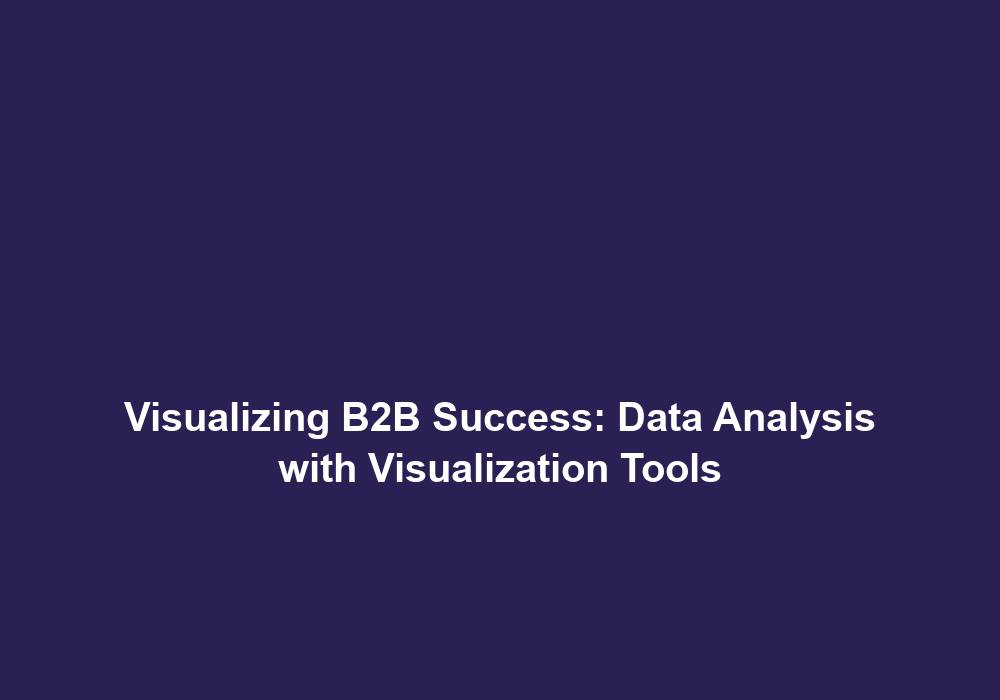In today’s digital age, businesses are generating enormous amounts of data on a daily basis. This abundance of data, commonly referred to as big data, holds great potential for B2B organizations to gain valuable insights and make informed decisions. However, the sheer volume and complexity of big data can make it challenging to extract meaningful information. That’s where analysis and reporting strategies come into play – they help businesses navigate through the vast sea of data and uncover actionable insights. In this article, we will explore some effective strategies for analyzing and reporting big data in B2B settings.
The Importance of Big Data Analysis in B2B
Big data analysis plays a crucial role in B2B organizations by providing valuable insights into customer behavior, market trends, and operational inefficiencies. By harnessing the power of big data analysis, businesses can make data-driven decisions, optimize their operations, and gain a competitive advantage in the market.
1. Data Collection and Preparation
Before diving into data analysis, it’s essential to collect relevant data and ensure its quality. B2B businesses can collect data from various sources such as customer transactions, website analytics, CRM systems, social media platforms, and more. The data collected should be relevant to the business objectives and aligned with the desired insights.
To ensure the accuracy and consistency of the collected data, it needs to be prepared before analysis. Data cleaning is a critical step in this process, as it involves identifying and correcting any errors, duplicates, or missing values. Additionally, data transformation may be necessary, which could include aggregating data, normalizing variables, or creating new derived variables. By thoroughly preparing the data, businesses can ensure that the results of the analysis are reliable and meaningful.
2. Defining Analytical Goals
To effectively analyze big data, it’s crucial to define clear analytical goals. What insights are you looking to extract from the data? Are you trying to understand customer preferences, identify market opportunities, or optimize pricing strategies? Defining specific analytical goals helps focus the analysis and ensures that the results are actionable.
By setting analytical goals, businesses can align their analysis efforts with their strategic objectives. This enables them to prioritize the analysis of certain data sets or variables that are most relevant to achieving their goals. By keeping the goals in mind throughout the analysis process, businesses can stay focused and extract the most valuable insights from the big data.
3. Choosing the Right Analytical Techniques
There is a wide range of analytical techniques available for big data analysis. Each technique has its strengths and weaknesses, and the choice of technique should depend on the nature of the data and the specific goals of the analysis.
Descriptive analysis is a commonly used technique that involves summarizing and visualizing the data to understand its basic characteristics. It helps in identifying patterns, trends, and outliers in the data. This technique is particularly useful for exploratory analysis and initial data exploration.
Predictive analysis, on the other hand, uses statistical models and machine learning algorithms to forecast future outcomes based on historical data. It can be used to anticipate customer behavior, predict market trends, or optimize business processes. Predictive analysis enables businesses to make data-driven decisions by providing insights into future trends and potential outcomes.
For more advanced analysis, prescriptive analysis takes predictive analysis a step further by recommending specific actions to optimize outcomes. It provides actionable insights for decision-making by simulating different scenarios and identifying the best course of action. This technique helps businesses optimize their strategies and make informed decisions based on data-driven recommendations.
Text mining and natural language processing techniques are used to analyze unstructured data, such as customer reviews, social media posts, or survey responses. Text mining helps in understanding sentiment analysis, customer feedback, and emerging topics. By analyzing unstructured data, businesses can gain valuable insights into customer opinions and preferences.
4. Data Visualization for Reporting
Data visualization is a powerful tool for communicating complex insights in a clear and intuitive manner. Visualizing big data helps stakeholders understand key findings and trends quickly. It enables businesses to present data in the form of graphs, charts, dashboards, or infographics.
When creating data visualizations, it’s crucial to choose the right type of visualization that effectively represents the data and highlights the key insights. Some commonly used visualization techniques include bar charts, line graphs, scatter plots, heat maps, and geographical maps. By selecting the most appropriate visualization techniques, businesses can effectively communicate their findings and make the data more accessible to a wider audience.
5. Building a Data-Driven Culture
To fully leverage the benefits of big data analysis, B2B organizations must foster a data-driven culture. This involves promoting data literacy among employees, encouraging data-driven decision-making, and investing in data analytics capabilities.
Leadership plays a vital role in building a data-driven culture by setting the example and championing the use of data in decision-making. Data-driven organizations often establish data governance frameworks, provide training programs, and create cross-functional teams to foster collaboration and knowledge sharing. By prioritizing data-driven decision-making and investing in the necessary resources and skills, businesses can create a culture where data analysis is valued and used to drive business outcomes.
Conclusion
Navigating big data in the B2B landscape requires effective analysis and reporting strategies. By collecting and preparing relevant data, defining analytical goals, choosing the right techniques, visualizing data, and building a data-driven culture, B2B organizations can unlock valuable insights and drive informed decision-making. As the volume of data continues to grow, mastering the art of big data analysis will become increasingly vital for businesses to stay competitive in the digital age.
[Note: This article is written in markdown format for easy readability and conversion to other formats such as HTML.]
